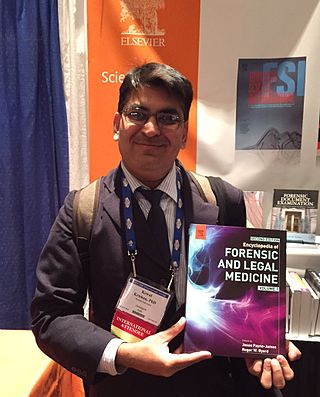Top Qs
Timeline
Chat
Perspective
Kewal Krishan (forensic anthropologist)
Indian forensic anthropologist (born 1973) From Wikipedia, the free encyclopedia
Remove ads
Kewal Krishan, an Indian forensic anthropologist, is a professor of physical anthropology and former Chair of Department of Anthropology and Dean, International Students at Panjab University, Chandigarh, India.[1][2][3] He has contributed to the development of forensic anthropology in India.[4] He is one of the very few forensic anthropology experts of the nation.[5][6]
This article contains promotional content. (October 2025) |
Remove ads
Early life and education
Krishan was born in 1973 in a small village Mullanpur Garibdass of District Mohali in Punjab state of north India. He studied at Munnalal Puri Government Senior Secondary School till 1987. He completed his bachelor's degree, Master's degree in Anthropology and earned Ph.D. in Forensic Anthropology in 2003 from Panjab University, Chandigarh, India. He is an elected fellow of the Royal Anthropological Institute of Great Britain and Ireland (FRAI).[7][8]
Remove ads
Ranking in career
Dr. Krishan has been continuously ranked amongst the top 2% scientists of the world since 2017 in the field of Legal & Forensic Medicine based on a study conducted by Stanford University scientists.[9][10] He is the only anthropologist from India listed in the prestigious world's top 2% scientists.[11][12] He was positioned at 16th rank in Legal & Forensic Medicine category worldwide in the year 2023.[13][14][15] In 2024, he has been ranked at 13th position among top 14,394 forensic scientists globally.[16][17] He is one of the most cited forensic scientists having 400 publications with more than 128,000 citations.[18] Krishan recently secured 3rd rank in the forensic anthropology research worldwide according to a bibliometrics study published by Journal of Forensic and Legal Medicine.[19]
Remove ads
Research and innovation
He extensively worked on various aspects of human morphology and their forensic applications in Indian populations.[20][21][22][23] He has contributed articles to the Encyclopedia of Forensic Sciences 2nd Edition and Encyclopedia of Forensic and Legal Medicine 2nd Edition published by Elsevier in 2013 [24][25] and 2016 [26][27][28] respectively. His most cited work pertains to the forensic podiatry of the north Indian population.[29][30] In one of his noteworthy work in 2008, he studied the effect of body weight and additional body weight on the footprints and its interpretation in crime scene investigation.[31] He also established some of the unique and individualistic characteristics of the footprints that are helpful in the identification of criminals.[32] He devised and calculated the effect of limb asymmetry on estimation of stature in forensic examinations.[33] He devised a novel index called Heel-Ball Index in the forensic literature emphasizing its relevance in sex determination.[34][35] He has published unique work on the footprint ridge density of Indian population and its significance in forensic identification.[36][37]
References
Wikiwand - on
Seamless Wikipedia browsing. On steroids.
Remove ads

